You'll want to make musk oil without ambrette seeds for several compelling reasons. The synthetic alternatives are more cost-effective at around $800 per kg, compared to expensive natural ambrette extraction. You'll also get better longevity, with synthetic musks lasting several days on skin and clothing. Plus, ambrette seed distillation can produce unwanted fatty odors and has limited shelf life. The world of synthetic and natural musk alternatives offers exciting possibilities for your perfume creations.
Understanding the Need for Ambrette-Free Musk Oil
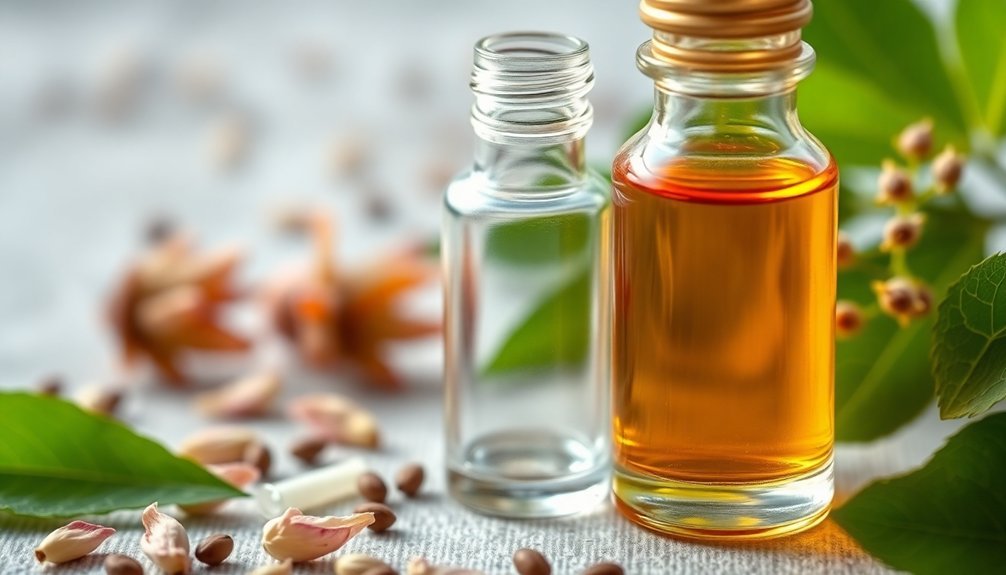
While ambrette seeds have traditionally been used to create natural musk oil, several compelling factors are driving the industry toward ambrette-free alternatives.
You'll find that cost plays a major role, as synthetic musk production costs around $800 per kg, making it considerably more affordable than natural ambrette seed extraction.
The quality and consistency issues you'd face with ambrette seed oil can't be ignored. Synthetic alternatives provide extraordinary longevity, often lasting several days on skin and clothing compared to natural options.
Steam distillation often results in fatty odors and limited shelf life, while synthetic alternatives offer stable, long-lasting formulations.
You're also able to achieve greater flexibility with synthetic musk, as it can be adjusted to create various scent profiles.
Additionally, you'll be making an environmentally conscious choice, as synthetic production reduces the strain on natural resources and eliminates concerns about sustainable cultivation.
Popular Natural Substitutes for Ambrette Seeds
Several natural botanicals can effectively replace ambrette seeds in musk oil formulations, each bringing unique characteristics to your fragrance blend. You'll find vetiver and patchouli offer earthy depth, while labdanum adds a sweet, herbaceous touch. Sandalwood's smooth, woody aroma creates an excellent musk-like base. Natural white musk ingredients promote ecological preservation through sustainable harvesting practices.
| Botanical | Key Note | Best Paired With |
|---|---|---|
| Vetiver | Earthy-Woody | Patchouli |
| Labdanum | Sweet-Herbal | Sandalwood |
| Tonka Bean | Powdery-Sweet | Vanilla |
When selecting your ambrette substitute, consider blending multiple botanicals for a more complex, authentic musk scent. While synthetic options exist, these natural alternatives provide sustainable, cruelty-free solutions that'll appeal to eco-conscious consumers. They're particularly valuable when dealing with ambrette's limitations like availability issues and processing complexity.
Essential Oil Combinations for Musk-Like Scents

Creating authentic musk-like scents requires strategic combinations of essential oils that work in harmony.
You'll find that blending deep, woody notes with spicy and sweet elements creates a complex musk profile without using ambrette seeds. The oriental and woody families provide the perfect foundation for these combinations. Customer reviews show the blend achieves a 5 out of 5 rating for its authentic musk-like qualities.
- Combine Patchouli Premium Dark with Agarwood for a rich, earthy base
- Layer Copaiba Balsam and Neem Co2 to add depth and complexity
- Add Vanilla Bourbon Co2 or Benzoin for sweet, creamy undertones
- Finish with Ginger Fresh to introduce a vibrant, spicy note
Don't forget to properly dilute your blend with carrier oils for skin applications, or use it full strength in diffusers.
Letting your creation mature in a cool, dark place will enhance the final fragrance profile.
Traditional Methods of Creating Synthetic Musk Notes
You'll need to understand the complex chemical structures of synthetic musks through detailed composition analysis before attempting any production.
Safety protocols in the lab require proper ventilation, protective equipment, and careful handling of nitrated compounds during synthesis.
Cost-effective manufacturing can be achieved through optimized mixing processes and the strategic use of modifying agents like sugars or polyols, which enhance stability without compromising the final product's olfactory properties.
Chemical Composition Analysis
Traditional synthetic musk compounds emerged from extensive chemical analysis of natural musk's complex composition.
You'll find that natural musk contains both water-soluble and fat-soluble components, with muscone making up 2-5% of its fragrant constituents.
Scientists have developed several types of synthetic alternatives to replicate these complex scent profiles.
- Nitro musks like musk xylene (1-t-butyl-3,5-dimethyl-2,4,6-trinitrobenzene) and musk ketone offer stable fragrance profiles
- Production methods involve mixing nitrated compounds with modifying agents at temperatures below 80°C
- Sugar-based modifying agents, including maltose and glucose, help stabilize the synthetic compounds
- Polycyclic musks provide additional options for creating musk-like scents without using natural sources
This chemical understanding has led to the development of cruelty-free alternatives that maintain consistent quality in fragrance products.
Lab Safety Protocols
When working with synthetic musk compounds in a laboratory setting, strict safety protocols must be followed to protect both personnel and the environment. You'll need to wear proper PPE, including gloves, goggles, and lab coats, while ensuring all work with volatile compounds occurs in fume hoods.
| Safety Measure | Key Requirements |
|---|---|
| Storage | Well-ventilated areas, sealed containers, proper labeling |
| Equipment | Calibrated GC-MS/MS, regular maintenance, trained operators |
| Disposal | Hazardous waste containers, compliance with regulations |
Remember that synthetic musks don't degrade easily in sewage systems and can accumulate in marine life. You must handle these compounds with care, as studies show they can affect gene expression and cellular defense mechanisms. Always follow MSDS guidelines and dispose of materials properly to minimize environmental impact.
Cost-Effective Manufacturing Methods
Manufacturing synthetic musk compounds cost-effectively relies on several well-established methods that combine specific musks with modifying agents.
You'll find that common synthetic musks like musk xylene, ketone, and ambrette can be mixed through dry, cold, or wet processes at temperatures below 80°C.
- Mix with modifying agents like sugars, ethers, or solid hydroxylated polyols
- Combine ingredients using dry mixing or wet alcohol-based solutions
- Use in situ mixing during musk xylene recrystallization for best results
- Add 5-10% modifying agents by weight for ideal stability
You can achieve stable, long-lasting musk compositions by carefully selecting non-toxic, odorless modifying agents that won't alter the musk's olfactory properties.
These methods guarantee your synthetic musk maintains its quality during storage while remaining suitable for perfumes and detergents.
Safety Considerations When Blending Musk Alternatives
Creating safe musk alternatives requires careful attention to both ingredient selection and blending protocols. When you're working with plant-based alternatives, you'll need to guarantee proper extraction methods, like supercritical CO2, to maintain safety and quality.
While botanicals like angelica root and galbanum offer safer options than synthetic musks, you must still follow proper handling procedures. You'll want to avoid synthetic musks that can cause skin irritation and hormone disruptions. Instead, focus on essential oils and botanical extracts that won't bioaccumulate in your body.
Always check ingredient transparency and look for appropriate certifications. Be particularly mindful of labeling requirements, as some ingredients may be hidden under generic terms like 'fragrance.' Document your blending ratios and maintain consistent quality control throughout the manufacturing process.
Achieving the Perfect Musk Base Note Balance
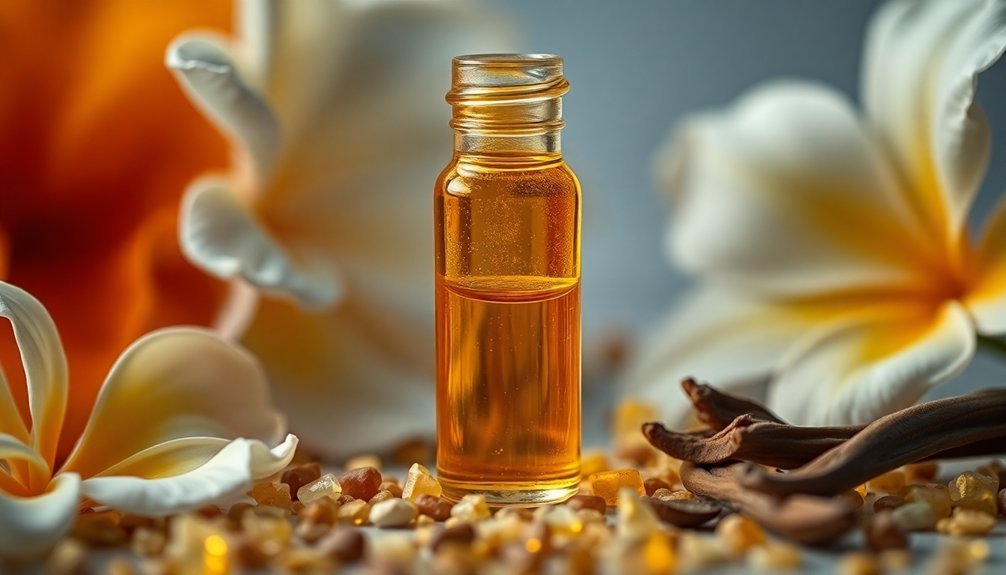
When you're creating a musk base note without ambrette seeds, you'll need to carefully layer your essential oils to mimic that signature warmth and depth.
You can harness the natural fixative properties of ingredients like vetiver, patchouli, or cedarwood to anchor your blend and extend its longevity.
The success of your musk alternative depends on precise blending ratios, typically starting with 15-20% base notes in your total composition to achieve that classic musky foundation.
Layering Essential Oil Notes
The art of layering essential oils requires a delicate balance to achieve a lasting musk fragrance without ambrette seeds.
You'll want to start with your base notes, which provide the deep, rich foundation that typically makes up 5-10% of your blend. Then, build upon this with middle notes comprising 50-75% of your mixture to create the heart of your fragrance.
- Begin with earthy base notes like vetiver or sandalwood in a glass roller bottle
- Add floral middle notes such as rose, jasmine, or ylang-ylang
- Layer in herbal elements like lavender or geranium
- Finish with bright top notes like bergamot or sweet orange
Test the blend on your skin and adjust the ratios drop by drop until you achieve your desired musky scent profile.
Natural Fixative Properties
Beyond the art of layering, understanding musk's natural fixative properties allows you to create longer-lasting fragrances without ambrette seeds. You'll find that synthetic musk offers the same stabilizing benefits as natural musk while adhering to ethical standards.
| Musk Properties | Benefits |
|---|---|
| Slow evaporation | Extends fragrance life |
| Stabilizing effect | Prevents note degradation |
| Harmonious binding | Balances all notes |
| Enhancement ability | Adds depth and complexity |
| Versatile blending | Works with multiple profiles |
While ambrette seeds can provide a musk-like aroma, they don't deliver the same fixative power as musk. You'll achieve better results using synthetic musk as your base note, as it effectively anchors volatile notes while maintaining the desired scent profile over time.
Blending Ratios Matter
Creating a balanced musk base note requires precise ratios and careful consideration of multiple components. When blending your musk oil without ambrette seeds, you'll need to carefully orchestrate the alternative ingredients to achieve that desired musky character.
- Start with a foundation of agarwood and vetiver, which provide the deep, woody undertones.
- Layer in copaiba balsam and patchouli to build the earthy, spicy elements.
- Add benzoin and vanilla CO2 for warmth and subtle sweetness.
- Finish with small amounts of valerian and gurjun balsam to round out the composition.
Remember that base notes are the most tenacious part of your perfume, so you'll want to test small amounts first.
Always start with the strongest components and gradually build up lighter notes to achieve the perfect balance.
Cost-Effective Options for DIY Musk Perfume
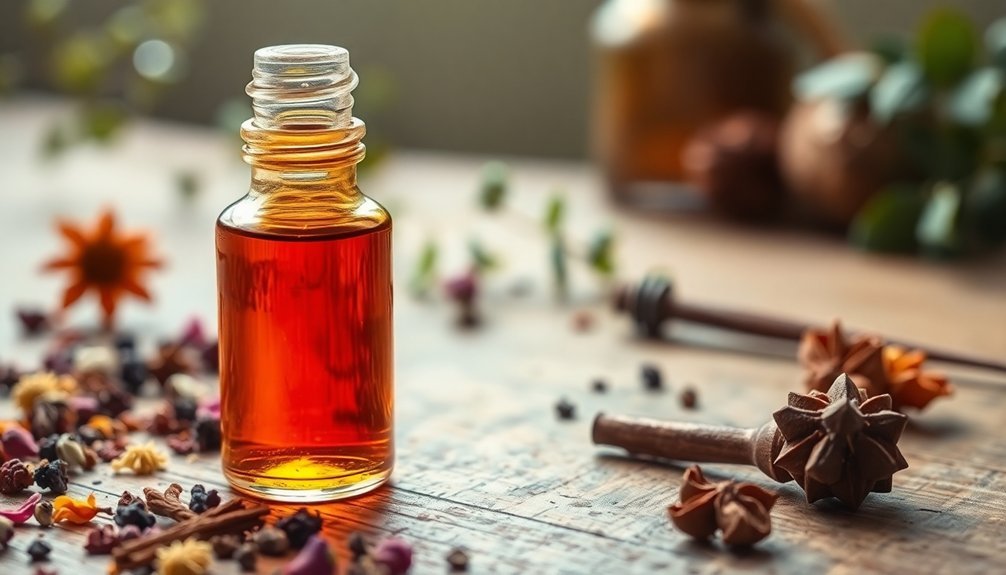
Making your own musk perfume doesn't have to strain your budget, as several affordable ingredients can replicate that coveted musky scent.
You'll find fossilized amber and vanilla essential oil are cost-effective alternatives that create rich, complex base notes. When combined with lavender oil, these ingredients deliver a balanced fragrance profile.
Start with readily available vodka or jojoba oil as your base, which you can find at most stores.
You'll need just 16 drops of essential oils per 10ml of carrier oil for a light perfume. To maximize your investment, store your creation in dark glass bottles and let it mature for several days.
This aging process guarantees your scents blend properly and last longer, giving you the most value from your ingredients.
Sustainable Ingredients for Natural Musk Blends
You'll find several sustainable alternatives to ambrette seeds in creating natural musk blends, including labdanum derived from cistus plants and angelica root extracted through eco-friendly CO2 methods.
These plant-based ingredients not only provide rich, musky undertones but also serve as natural fixatives that help extend your fragrance's longevity.
Plant-Based Musk Sources
While traditional musk scents often relied on animal sources, plant-based alternatives now offer sustainable and cruelty-free options for perfumers and fragrance enthusiasts.
You'll find that nature provides several botanical ingredients capable of creating musky notes without compromising quality or ethical standards.
- Clary sage produces Ambroxan, delivering warm, ambery undertones
- Galbanum contributes earthy, musky characteristics to fragrance blends
- Angelica root adds an herbal-musky dimension to scent profiles
- Various flowers and herbs can mimic traditional musk notes
These plant-based sources not only align with clean beauty standards but also provide consistent scent profiles and cost-effective solutions.
You'll appreciate how these ingredients can be blended to create complex fragrances while maintaining ethical sourcing practices and environmental responsibility.
Natural Fixative Options
Creating lasting musk fragrances requires effective natural fixatives that anchor and extend the scent profile. You'll find several plant-based options that work exceptionally well.
Benzoin and labdanum offer sweet, smooth characteristics while providing excellent staying power. Myrrh and frankincense deliver warm, earthy notes that help ground your musk blend.
For a deeper, more complex foundation, you can incorporate sandalwood or patchouli, both known for their strong fixative properties and complementary woody notes.
Vanilla and orrisroot add creamy, powdery elements while helping to stabilize the fragrance.
If you're seeking alternatives to traditional animal-derived fixatives like ambergris or civet, consider natural resins like tolu balsam or storax, which provide similar anchoring effects with their rich, balsamic qualities.
Eco-Friendly Extraction Methods
Modern fragrance creation demands sustainable extraction methods that minimize environmental impact while maximizing the purity of natural ingredients.
You'll find that eco-conscious extraction processes have revolutionized how we obtain musk-like scents without relying on ambrette seeds.
- Supercritical CO2 extraction captures a wide range of compounds while remaining environmentally benign, using CO2 that's already present in the atmosphere.
- Subcritical extraction preserves oil integrity through lower temperatures and pressure, making it both eco-friendly and cost-effective.
- Synthetic musk production in labs guarantees consistent scent profiles without animal exploitation.
- Plant-based alternatives offer sustainable options that work well with various fragrance families.
These methods demonstrate how you can create authentic musk scents while maintaining environmental responsibility and achieving reliable results in your fragrance formulations.
Preservation Techniques for Homemade Musk Oil
To guarantee your homemade musk oil remains fresh and potent, proper preservation techniques are essential.
Start by using alcohol as both a solvent and preservative to stabilize the essential oils and prevent oxidation. Store your musk oil in dark, sterilized bottles and keep them in a cool, dark place away from heat sources and direct sunlight.
You'll want to incorporate natural preservatives like vitamin E oil, grapefruit seed extract, or antimicrobial essential oils such as tea tree oil.
Consider adding a small amount of citric acid or salt to prevent microbial growth. Make smaller batches to ensure you'll use the product before it degrades, and let it age for a few weeks to improve stability.
Remember to check your musk oil regularly for any signs of contamination or changes in appearance and smell.
Scaling Your Musk Oil Production at Home
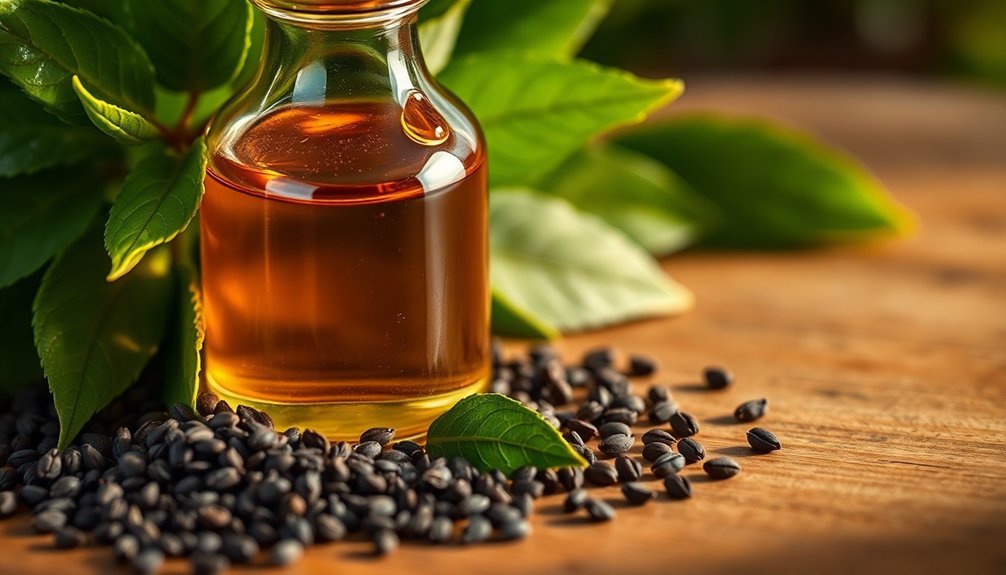
When scaling up your musk oil production at home, focus on efficiency and maintaining quality control throughout the process.
Without ambrette seeds in your recipe, you'll find it easier to maintain consistency across larger batches while keeping your production costs manageable.
- Start with small test batches to perfect your recipe ratios before scaling up
- Use traditional ingredients like rose oil and sandalwood for authentic fragrance
- Document each step of your process to guarantee reproducible results
- Store your ingredients properly to maintain their stability and shelf life
Frequently Asked Questions
Can Musk Oil Trigger Allergic Reactions in People With Seed Sensitivities?
If you're sensitive to seeds, you'll need to be careful with musk oil, as it can trigger allergic reactions. You might experience skin irritation, respiratory issues, or systemic reactions from exposure.
How Long Does Homemade Musk Oil Retain Its Fragrance?
Your homemade musk oil will typically last 2-3 years if you store it properly in cool, dark conditions. You'll get the best longevity by blending it with carrier oils and adding natural preservatives.
Does Musk Oil Stain Different Types of Fabric?
Yes, musk oil can stain your fabrics. You'll need to be especially careful with delicate materials like silk and wool. It's also tough to remove from cotton since the oils don't easily wash out.
Can Musk Oil Be Used in Cold Process Soap Making?
Yes, you can use musk oil in cold process soap making. You'll need to add it at trace, use a fragrance calculator for proper amounts, and guarantee thorough mixing for even distribution throughout your soap.
What's the Best Temperature Range for Storing Musk Oil Blends?
You'll want to store your musk oil blends between 15-21°C (60-70°F) in a stable environment. Keep them away from heat sources and direct sunlight to prevent degradation and maintain their quality.
In Summary
You've learned how to create beautiful musk fragrances without ambrette seeds, opening up new possibilities for your perfumery. Whether you're avoiding allergens, seeking sustainable options, or working within budget constraints, you'll find that natural alternatives and synthetic musks can produce stunning results. Keep experimenting with different combinations and ratios until you've crafted your perfect signature musk blend.

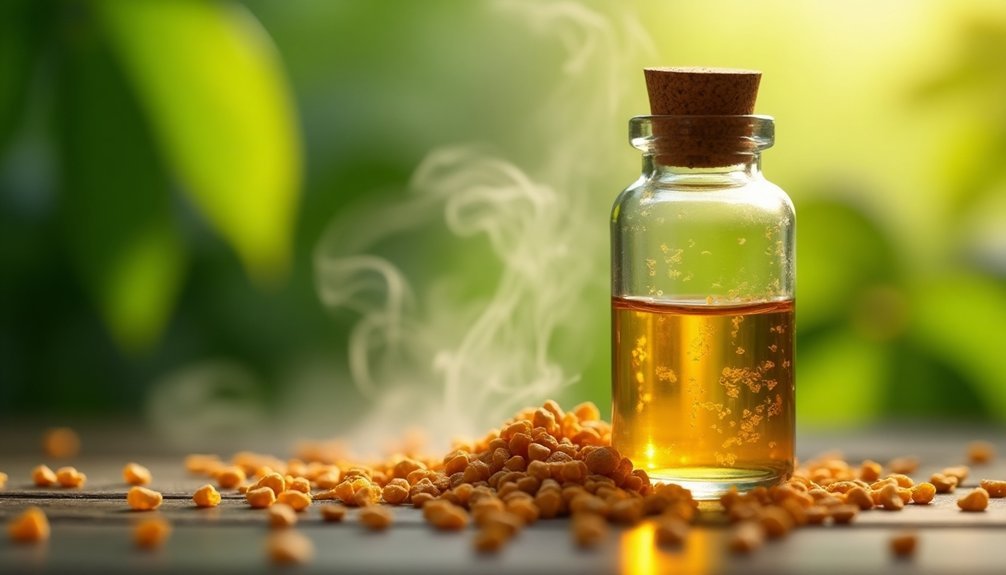



Leave a Reply